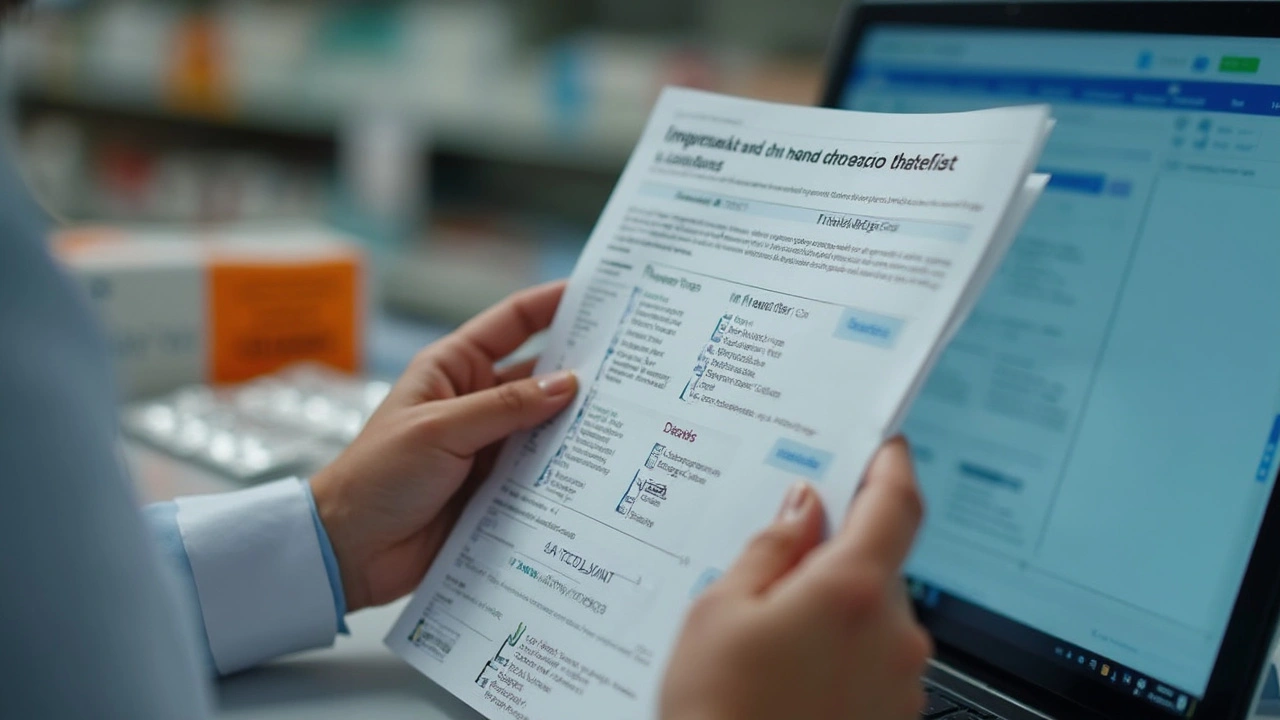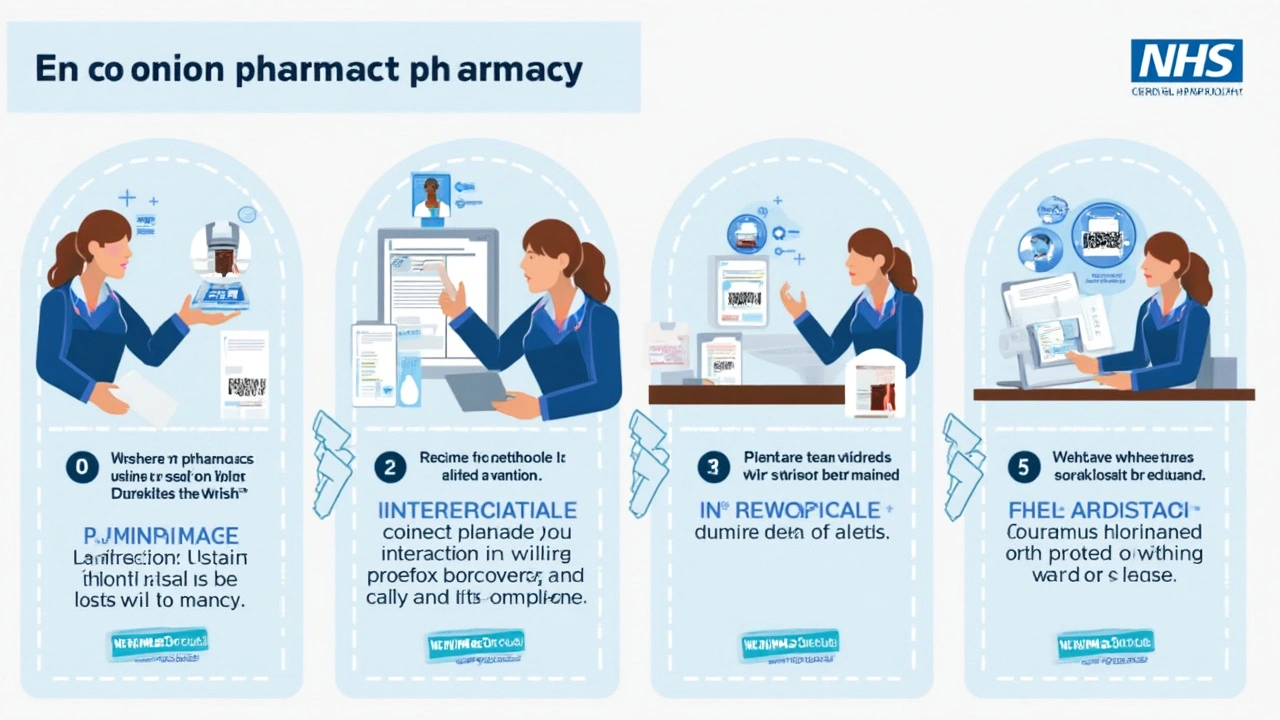Imipramine might look like just another tab on the shelf, but this old-school antidepressant likes to play by its own rules. Ask any experienced pharmacist—they’ll tell you about the calls from anxious GPs, worried family members, sometimes even patients who swear that their new rash, fainting spell, or burst of confusion started right after adding another medication to imipramine. It’s a potent tricyclic with a mile-long interaction list, but what does practical screening look like when you’re juggling a line of customers and ringing phones in a community pharmacy? Let’s break down the step-by-step protocol that actually works when you’re on the ground.
Understanding Imipramine’s Profile: What’s at Stake
You can’t spot a problem with imipramine co-prescriptions until you know its quirks. This is not aspirin—it’s a tricyclic antidepressant with strong anticholinergic actions, cardiac risks, and a metabolism that drags plenty of other meds into its orbit. Imipramine gets broken down by cytochrome P450 enzymes—mainly CYP2D6 and CYP1A2—which means anything that can nudge those enzymes will mess with imipramine’s levels. In plain English: tons of drugs can make imipramine stronger or weaker in the body, bringing either side effects or therapeutic failure.
On top of the metabolic chaos, imipramine’s side effect radar glows for heart rhythm problems, a drop in blood pressure, confusion (especially in older people), constipation, dry mouth, and even seizures at high doses or in sensitive folks. Combine it with other meds, and the risks aren’t just theoretical. There are enough real-world, published case reports linking imipramine interactions to hospital admissions, even deaths, to make a pharmacist nervous for all the right reasons.
Here’s a quick snapshot to put things in perspective:
| Risk | Potential Outcome |
|---|---|
| QT Prolongation | Sudden cardiac arrhythmia |
| Serotonin Toxicity | Confusion, tremor, fever, restlessness |
| Increased Anticholinergic Load | Cognitive decline, constipation, urinary retention |
| Metabolic Inhibition (e.g., CYP2D6 blockers) | Toxic levels, seizures |
| Combination with CNS depressants | Enhanced sedation, respiratory depression |
The punchline? When pharmacist screening slips up, patients can wind up in an ambulance. You want a system, not a hunch.
The Front Counter Reality: Fast, Systematic Screening Protocol
Screening isn’t about memorization or fancy software alone—you need a practical mental checklist that you can work through quickly and clearly. Here’s how many of us in Aussie community pharmacies screen imipramine co-prescriptions, step by step, and stay calm even when the shop’s bustling.
- Start With the Patient’s Story
Before you check a database, get the facts. Age, current diagnoses, and that all-important recent med history. Imipramine is riskier in people over 65, in anyone with a known heart issue, or someone on a laundry list of meds. Ask—has there been a recent medication change? Is this a new or just a repeat script? Listening saves time later. - Quick-Scan for Top Risk Combos
Mentally run through usual suspects that crop up often: antihistamines, antipsychotics, other antidepressants, antiarrhythmics, antibiotics like erythromycin or ciprofloxacin, and even over-the-counter sleep aids. Don’t forget anything with ‘-zine’ or ‘-pine’ in the name—those anticholinergic and antipsychotic effects have a nasty way of stacking up. - Interaction Database Double-Check
Yes, your brain remembers a lot, but this is where you back yourself up. Don’t rely on printouts from five years ago, either. For detailed and updated interaction data, there’s an online resource you should have bookmarked. Need somewhere to quickly check imipramine interactions? Hit that link and bookmark it for good. It covers clinically significant, rare, and even oddball interactions that the standard pharmacy software might skip. - Watch for Metabolic Blockers—The Sneaky Ones
A surprising culprit on review? Meds like fluoxetine, paroxetine, bupropion, quinidine. They slam the brakes on CYP2D6, causing imipramine to rise unexpectedly. If you spot it, flag it for the prescriber. - Flag QT-Interval Risks
If the patient’s got anything that drags out the QT interval—be it a known risk drug or a medical history of arrhythmia—imipramine is not a casual pick. Check the meds and history for macrolide antibiotics, antiarrhythmics, some antipsychotics, and even domperidone. Always check if an ECG is recommended or already done. - Review Anticholinergic Pile-On
The classic ‘dry mouth, can’t pee, can’t poop, confused granny’ syndrome isn't a joke. Older adults with a prescription for imipramine should be flagged if they've also got scripts for things like oxybutynin, diphenhydramine, or tricyclics. - Document and Communicate—Don’t Just Click OK
If anything makes you hesitate, send a brief note—written or verbal—to the GP or psych. Even if the patient’s tolerated the combo before, bodies (and brain chemistry) change over time. Never assume yesterday’s tolerance is tomorrow’s safety.
Don’t forget—all these steps together take under five minutes with practice, and they stop 99% of preventable problems at the counter.

Common Interaction Scenarios: What Pharmacists See Most
Here’s where stories from the pharmacy floor matter. These are the interaction scenarios that come up again and again with imipramine:
- Imipramine + Fluoxetine: This one’s infamous for boosting imipramine levels and flirting with toxicity. The sedation, confusion, and arrhythmia risk can shoot up. Always warn the doctor and check if a lower dose is needed or swap is possible.
- Imipramine + Multiple Anticholinergics: Old-school bladder meds, allergy tablets, and even some cold and flu remedies can combine to make life miserable, especially for elderly folks. Look out for signs—patients may mention constipation, dry mouth, or trouble peeing, but are often too embarrassed unless prompted.
- Imipramine + Tramadol: This pair can increase the risk of serotonin syndrome—cue agitation, muscle twitching, fever. Any time you see these together, double-check the indication and talk to the prescriber if you see even a hint of symptoms.
- Imipramine + Erythromycin/Ciprofloxacin: Cardiac warning. Both these antibiotics can drag out the QT interval even further, so don’t let the combination slip through—flag it for immediate medical review.
- Imipramine + CNS Depressants (like benzodiazepines or alcohol): Layered sedation, falls, and confusion—the trio nobody wants. Document any advice you give around avoiding these combos, especially in fragile or elderly patients.
Spotting these before you dispense saves lives. Each one tells a story, sometimes of disaster averted, sometimes of lessons learned the hard way on busy Saturday mornings.
Essential Counselling Tips for Patients and Carers
It’s one thing to find a risky combo, but even more important is what you do next. The best pharmacists turn this dry checklist into an actual conversation with patients and carers. Run through what to watch for—don’t assume anyone reads the CMI leaflet at home (spoiler: they rarely do).
- Heart palpitations, fainting, chest pain—get medical help URGENTLY if these pop up.
- Notice increased drowsiness or confusion, especially if combined with other sedatives—tell someone immediately.
- Unusual muscle twitches, sweating, restlessness—could be early serotonin syndrome.
- Watch bowel and bladder function, especially in older adults—constipation and trouble urinating can turn serious.
- If they start a new medication from any doctor, remind them to always mention they are on imipramine before taking even a single dose.
Be direct, plainspoken, and a bit repetitive with the important bits—repetition saves lives. A moment chatting at the counter can make all the difference. Even seasoned patients sometimes need reminding of the basics.

Proactive Strategies: Making Screening Part of the Pharmacy Culture
Once you’ve got the protocol sorted, how do you lock it in as a habit for everyone? It’s not just about ticking boxes—it’s the little routines that make screening second nature. Split the workflow so that even if you’re short-staffed, your pharmacy never misses a beat.
- Keep updated quick-reference posters near dispensing stations for the top five risky imipramine interactions and symptoms to flag. Out of sight, out of mind. In sight, always handy.
- Run interactive staff meetings every couple of months where you quiz each other with ‘What would you do if...?’ scenarios. Make it a competition with a coffee voucher on the line—everyone remembers the scenarios that way.
- For every new co-prescription of imipramine and another drug flagged in your system, get in the habit of checking with that online resource to check imipramine interactions. Make sure every tech and intern knows this is the gold standard step before dispensing.
- Share memorable case studies (keeping patient details private, obviously) so the risk feels real to the team. A vague theoretical risk can be shrugged off—a story about a neighbor’s grandmother going to hospital sticks in everyone’s mind.
Step-by-step protocols work, but they only become reliable when everyone in the pharmacy treats them as a daily ritual, not a one-off event. If you keep the culture sharp, your patients get safer, your day gets less stressful, and you sleep better at night.
The upshot? Screening imipramine co-prescriptions doesn’t make you paranoid—it makes you the kind of pharmacist every doctor and patient secretly hopes is on duty. In an age of generic dispensing and blink-and-you-miss-it consultations, this careful, real-world checklist saves time, money, and lives. Your brain is better than any software, as long as it’s got the right backup—and that step-by-step routine means you’re always a step ahead, not scrambling in panic.


mike brown
May 21, 2025 AT 15:25The pharmacy world loves its dramas, not its checklists.
shawn micheal
May 23, 2025 AT 14:33Hey folks, great to see a practical guide that actually acknowledges the chaos on the floor.
When you break it down step‑by‑step, it becomes way less intimidating for the newer techs.
Keeping the patient story first really humanizes the whole process and saves a ton of back‑and‑forth.
Also, flagging the QT risk early can prevent a heart‑stopping surprise later.
Keep sharing those real‑world anecdotes, they make the checklist feel alive.
Stephen Jahl
May 25, 2025 AT 22:06In the grand tapestry of pharmocological stewardship, the interstice wherein imipramine intersects with the myriad of cytochrome‑mediated substrates constitutes a veritable crucible of clinical exigency.
One must, with perspicacious alacrity, delineate the ontological parameters governing CYP2D6 and CYP1A2 inhibition, lest the resultant pharmacokinetic perturbations precipitate iatrogenic cataclysms.
The anticholinergic burden, when compounded by adjunctive antihistaminics or antipsychotics, engenders a synergistic diathesis that culminates in cognitive decline and visceral dysmotility.
Furthermore, the electrophysiological perturbations-specifically QT prolongation-necessitate a rigorous electrocardiographic surveillance protocol, especially in polypharmacy contexts.
Serotonin syndrome, an often underappreciated sequela, demands vigilant monitoring of neuromuscular hyperactivity and autonomic instability.
It is incumbent upon the pharmacist to operationalize a systematic algorithmic schema that integrates patient age, comorbid cardiac pathology, and concomitant CNS depressants.
The algorithm should be instantiated within the dispensing workflow, thereby obviating reliance on retrospective chart reviews.
Moreover, the utilization of contemporaneous interaction databases supersedes reliance on antiquated compendia, ensuring that esoteric but clinically salient interactions are not eclipsed.
In practice, a bifurcated approach-initial heuristic triage followed by definitive electronic verification-optimizes both time efficiency and safety fidelity.
Documentary rigor, manifested through succinct yet comprehensive notes directed to the prescriber, fortifies the interprofessional communication conduit.
One must also contemplate the pharmacodynamic ethos whereby synergistic sedative load amplifies fall risk in geriatric cohorts.
Thus, patient counseling must be couched in layperson vernacular, emphasizing early symptom reporting of dizziness, palpitations, or urinary retention.
Institutionalizing educational micro‑sessions, supplemented by case‑based learning, cultivates a culture of perpetual vigilance.
Consequently, the pharmacist transcends the role of dispenser, emerging as a sentinel of therapeutic integrity.
In summation, the confluence of precise pharmacokinetic appraisal, judicious clinical judgment, and proactive patient engagement coalesces to mitigate the latent perils inherent to imipramine co‑prescription.
gershwin mkhatshwa
May 28, 2025 AT 19:33Yo, this guide is solid – I love the quick‑scan list, makes life easier when the line’s snake‑like.
Honestly, the thing about “‑zine” or “‑pine” really helped me catch a nasty combo last week.
Just a heads‑up: a friendly reminder to the patient about not mixing over‑the‑counter sleep aids is gold.
And those poster ideas? Put them up near the register, everyone sees them while they’re waiting.
Louis Robert
May 30, 2025 AT 13:13Thanks for the concise bullet points; they’ll fit nicely into our daily brief.
tim jeurissen
June 1, 2025 AT 20:46While the previous exposition was elaborate, it suffered from numerous grammatical lapses; for instance, "pharmocologic" should be "pharmacologic," and "interstice" was misapplied in this context.
Precision in terminology is not merely pedantic but essential for clear interprofessional communication.